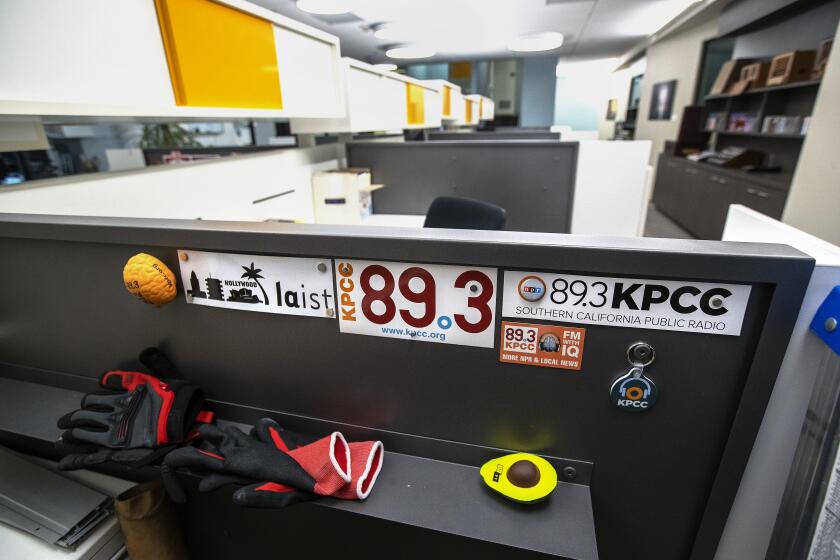Curbed aspirations
The future of the American Stock Exchange looked bright when Ira Koondel arrived in 1969.
A bull market was in full swing and the Amex was packed with traders. So many people worked on the main floor that the exchange had to open an upper level with bleacher seats a few years later.
Another bull market is roaring today, but life at the Amex is quite different.
Traders have slowly left or been fired. The bleachers are all but abandoned. Koondel, 65, operates from a dingy brown booth with three nonworking phones. “We’re not particularly interested in how things look because as things change, we may not be here anymore,” said Koondel, a heavyset man who wears American flag ties under his colorful trader’s smock.
The Amex, like other exchanges, has been hit hard by the spread of electronic trading. Computers increasingly do the work once performed by middlemen. Some regional marketplaces, including the Pacific Stock Exchange in Los Angeles, are gone.
Even the mighty New York Stock Exchange has been forced to evolve. In the last two years, it bought an electronic exchange, converted itself into a publicly traded company and downsized its trading floor. Seeking a global presence, it is acquiring Europe’s biggest stock-exchange company and recently struck a trading alliance with the Tokyo Stock Exchange.
The Amex also is trying to reinvent itself, but whether it can succeed is an open question.
For starters, it has long existed in the shadow of the NYSE, where the stocks of such corporate titans as General Electric Co. and IBM Corp. are listed. The Amex claims the likes of National Lampoon Inc. and Boots & Coots International Well Control Inc.
The NYSE’s columned building is perhaps the most powerful symbol of Wall Street, standing majestically in the heart of the financial district across the street from Federal Hall, where George Washington was inaugurated as president.
The back of the Amex’s Art Deco building, by comparison, is down the street from the Pussycat Lounge and the Thunder Lingerie & More sex shop.
The Amex took a step forward last month by hiring an investment bank to help it convert from an institution owned by its seat holders to a for-profit company.
The conversion would allow the Amex to raise money from outside investors or an initial public stock offering, but it also could pave the way for its sale to a larger rival -- and the end of the road.
“They have one more shot at getting this right,” said Doug Atkin, chief executive of Majestic Research, a New York stock-research firm.
“And if they do, they’re in good shape. And if they don’t, they will end up being completely irrelevant.”
Although its prospects may be cloudy, the Amex holds a special place in the hearts of many on Wall Street because of its origins.
In the 19th century, many Jews and Irish Catholics were denied membership in the NYSE, so they did their business out on the curb. That led to the founding of the New York Curb Market Agency in 1908.
For decades, these blue-collar brokers met outside -- in all kinds of weather -- until finally moving indoors in 1921. The agency was renamed the American Stock Exchange in 1953.
For most of the last century, it existed as a proud No. 2, sometimes serving as the first trading ground for up-and-coming companies before they grew and moved to the NYSE.
But rather than improve its standing over time, the Amex became a perennial also-ran, undermined by chronic bad luck and years of miscues.
The Amex has been extremely innovative -- getting in early on the booming stock-option business and helping to pioneer hugely popular exchange-traded funds, which are mutual funds that trade like stocks.
But in both cases, rivals stepped in and stole much of the business, leaving the Amex with a small slice of the pie.
Neal Wolkoff, the Amex’s chief executive, is painfully aware of the exchange’s status and hopes to change it.
“Your older brother is named the Big Board,” he said of the NYSE. “What does that leave for you? To be the Little Board?”
Since coming aboard two years ago, Wolkoff oversaw the introduction of a system that has cut transaction time from nine seconds -- an eternity on Wall Street -- to less than a second, helping boost its share of trading in certain securities.
“Granted, there’s a healthy level of skepticism,” Wolkoff said, “and I wouldn’t ask anybody to be a true believer until we demonstrate [success], but right now we’re hitting our goals.”
Some outsiders agree.
Thomas Peterffy, chief executive of Interactive Brokers, an institutional trading firm in Greenwich, Conn., said the Amex’s ability to create innovative products gives it an edge.
“They have a chance to survive and maybe even prosper,” Peterffy said.
The Amex also is getting an assist from a surge in investors’ appetite for shares of exchange companies themselves. Investors are betting that dozens of exchanges around the world will merge into a handful of mega-players. Those exchanges that are acquired could fetch premium prices, while the companies that survive are expected to be more cost-efficient and profitable.
Such expectations have helped drive up the price of NYSE Group Inc., which went public last March at $64.25 a share and now trades above $90.
Talk of the Amex going public has helped push up the price of an Amex seat -- basically an ownership stake that confers trading privileges -- to $400,000 from $92,000 when Wolkoff took over.
But that’s far less than the peak price of more than $700,000 in 2000, and not much more than the $315,000 that Koondel paid for his seat 38 years ago.
The Amex’s predicament dates to the 1970s, when financial markets were revolutionized by the creation of Nasdaq. Unlike the Amex and NYSE, where traders swap stocks in person, Nasdaq linked traders around the country by computer.
In what would be a running theme, the Amex failed to upgrade its technology to match Nasdaq’s much faster computer systems.
“We quite frankly were slow to take them seriously,” said Matthew Frank, a former Amex trader who is chairman of the exchange’s parent company, Amex Membership Corp.
As Nasdaq surpassed it in stocks, the Amex in 1975 moved into the trading of options, which allow investors to bet on the direction of stock prices.
But the Amex didn’t keep its trading systems up to date, experts say, and was surpassed by an electronic competitor in 2003, the International Securities Exchange. It slid to fifth place in January, according to Options Clearing Corp.
The Amex sold itself to Nasdaq’s parent company in 1998 on the expectation that its new owner would spend heavily to modernize the trading system. But the upgrades weren’t made, and the Amex fell even further behind its competitors. The marriage was unwound two years ago, with Amex members taking back the exchange.
Through it all, some public companies have remained loyal to the Amex. One is Wesco Financial Corp., a Pasadena-based insurance and furniture-rental business that is majority-owned by Warren Buffett’s Berkshire Hathaway Inc.
Charles Munger, Buffett’s longtime partner and Wesco’s chief executive, said the fees that companies pay to have their stock traded are much lower on the Amex than on other exchanges.
Wesco shareholders, he added, care about the company’s performance, not where its shares are listed.
“They would seek it out if the stock were traded in hell,” Munger said.
Koondel, now an option trader, started at the Amex as a floor broker. His job was to roam the exchange, buying and selling stocks on behalf of investment firms.
“This place was really busy,” Koondel recalled. “Guys were running around all over the place.”
Koondel believes the Amex’s prospects are better than they’ve been in many years. But he also has seen a steady outflow of traders, with computers taking their place.
“We don’t have many new people coming down here,” Koondel said.
“There’s not much opportunity now in the sense that there was when I came down here.”
*
(BEGIN TEXT OF INFOBOX)
Big board, little board
Comparing the New York Stock Exchange and the American Stock Exchange
*--* NYSE Amex Avg. daily trading volume 2.3 billion 70.9 million No. of companies listed 2,713 594 No. of employees 2,578 580 Year founded 1792 1908
*--*
Most active stocks, daily dollar trading volume
NYSE
(In millions)
Exxon Mobil: $901.1
Goldman Sachs Group: $572.6
Citigroup: $497
---
Amex
(In millions)
Ultra Petroleum: $88.4
NVR: $38.4
Grey Wolf: $24.1
---
Sources: NYSE, Amex






